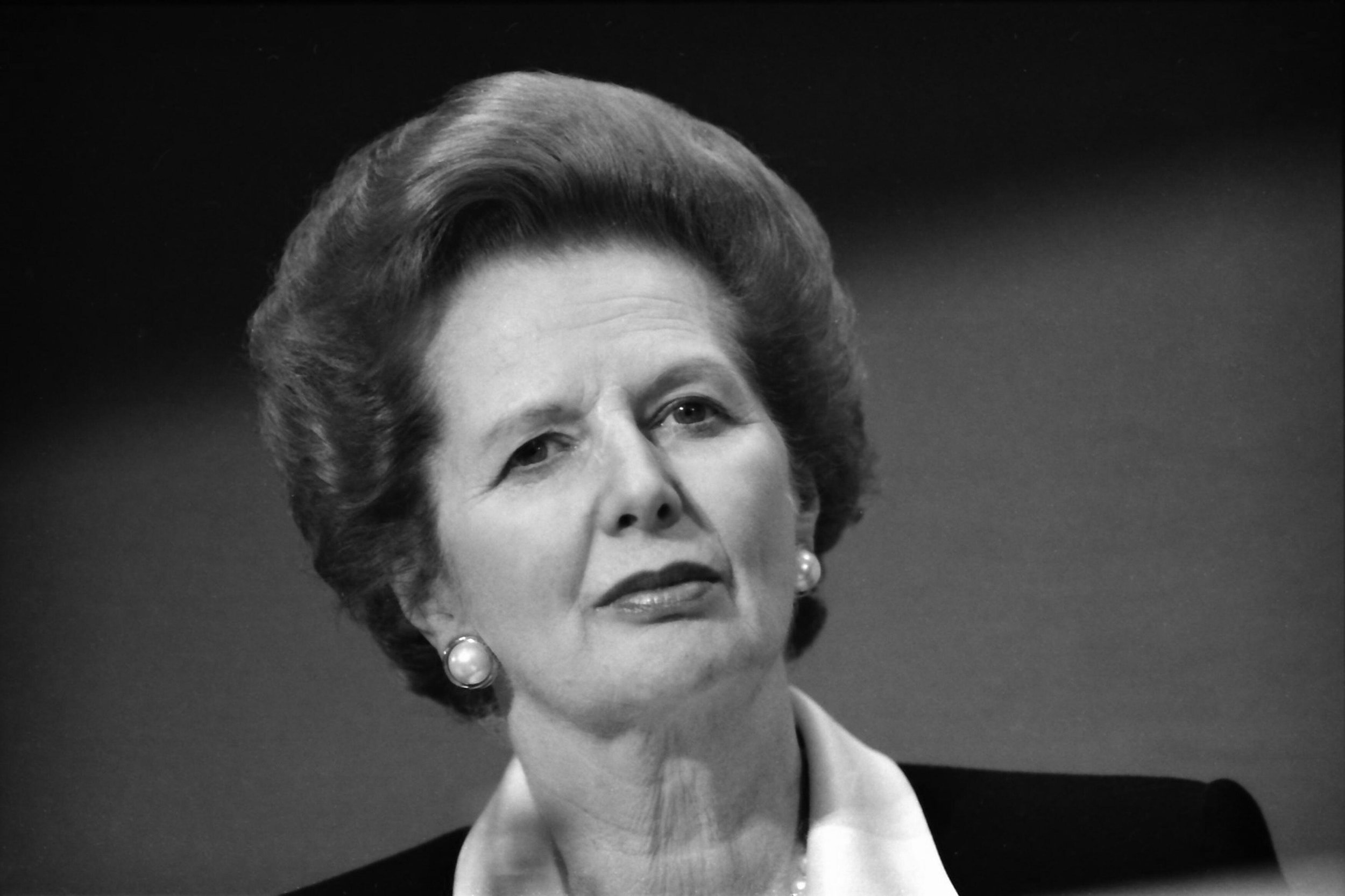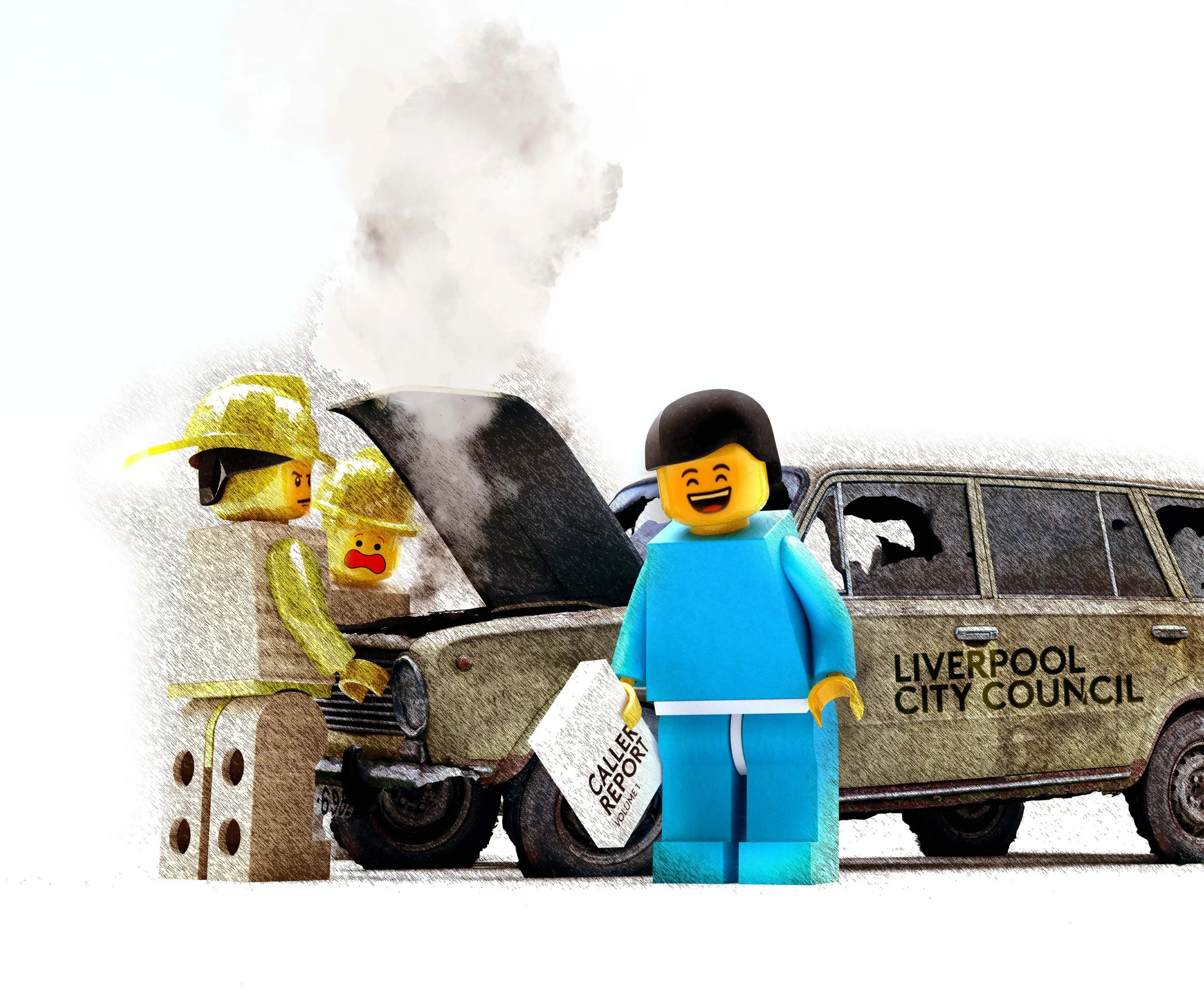Recent features
Mancpool: One Mayor, One Authority, One Vision?
Should the city of Liverpool throw in its lot with Manchester and accept one combined North West Metro Mayor to rule us all? Despite admitting that such a suggestion is about as saleable as a One State Solution for Israel-Palestine, Jon Egan thinks it’s an idea whose time has come. It’s certainly an idea that’s provoked some debate within Liverpolitan Towers. But what do you think?
Jon Egan
Manchester Bees Meet Liverpool Super Lambananas by mmcd studio
Is it time the city of Liverpool threw its lot in with Manchester and accepted one combined North West Metro Mayor to rule us all? Jon Egan thinks so. As you can imagine, the suggestion has caused some debate in Liverpolitan Towers and we are not all in agreement. But what do you think? Here Jon makes his case and hints at future initiatives to come…
So let me issue a warning now. This article contains material that many Liverpudlians will find deeply distressing and offensive. It’s an argument that I have tentatively proffered in the past, but after profound and serious reflection, have concluded, now needs to be set out in the most explicit and uncompromising of terms. You have been warned.
David Lloyd’s recent article for The Post lamenting the exodus of Liverpool’s “best and brightest” was as ever an enlightening and enjoyable read, notwithstanding its downbeat and dispiriting narrative of civic and economic decline. If I can add a generational postscript in support of David’s thesis, every member of our youngest daughter’s friendship group from Bluecoat School now lives and works outside Liverpool.
It was the nineteenth century philosopher, Friedrich Nietzche who argued that only as an “aesthetic phenomenon” does the tragedy of human existence find its eternal justification, and perhaps it’s only in the exquisite prose and imaginative virtuosity of David’s writing that Liverpool’s own tragic predicament becomes philosophically palatable. I admire David’s resolute determination to find some tiny component of hope, offered in the city’s joyously ephemeral hosting of Eurovision 2023. But does our capacity for celebration, hospitality and togetherness provide the alchemy for a viable economic renaissance? Does it, at best, illuminate Liverpool’s status as a half-city, stripped of its economic and productive assets, now reduced to the sheer potentiality of its human capital?
The idea of Liverpool as a stage set for cultural spectacles and entertainment extravaganzas (hyperbolically described by the city’s cultural supremo, Claire McColgan as “moments of absolute global significance”), is a beguiling substitute for an actual economy, and an ability to offer a livelihood for the generations who continue to depart for more attractive and seemingly successful cities. It’s a vision that also reminds me of another of Italo Calvino’s magical realist parables in his masterpiece novel, Invisible Cities. Sophronia, the half-city of roller-coasters, carousels, Ferris wheels and big tops, where it is the banks, factories, ministries and docks that are dismantled, loaded onto trailers and taken away to their next travelling destination.
“I fully grasp the deeply heretical nature of this proposition. A ‘One State’ solution for the Liverpool and Manchester City Regions is about as saleable as a one state solution for Israel and Palestine.”
Two hundred years ago, the realisation that we were a half-city inspired Liverpool’s city fathers to contemplate a project that would have world-changing implications - a genuine moment of “absolute global significance”. Prior to the construction of the world’s first inter-city railway, every human journey between major population centres would be dependent on the locomotive capabilities of the horse. Railways were the harbingers of modernity, compressing time and space, and in this instance, connecting one of the world’s great trading centres with its greatest manufacturing hub. Umbilically conjoined, the two half-cities (the place that trades and the place that makes), became the nexus for Britain’s industrial and imperial prowess for the next hundred years.
If the railway brought Liverpool and Manchester closer together, recent decades have been dominated by a football-terrace inspired antagonism aimed at driving us further apart. Liverpool’s antipathy to our more affluent neighbour would seem also to betray more than a slight hint of jealousy, as our rival has greedily accumulated the trappings and status of regional capital.
Rather than resenting Manchester’s success or investing in a strategy of do-or-die competition, is there a smarter and mutually beneficial alternative? Is it time to re-imagine a more symbiotic relationship, that realises that for every British provincial city, the real competition is located 200 miles to the south?
Of course, this is not an original proposition. In the early noughties, Liverpool Leader, Mike Storey and his Manchester counterpart, Richard Leese signed their much lauded Joint Concordat - an agreement only marginally less shocking than the Molotov-Ribbentrop ‘Non-Aggression’ Pact of 1939 between Nazi Germany and the Soviet Union. The benefits were equally short lived. The agreement was conceived in the golden age of regionalism when under the aegis of John Prescott’s mega-ministry - the Department for the Environment, Transport and the Regions - levelling-up and rebalancing were not mere meaningless mantras but core political imperatives. For all its good works, the now defunct North West Development Agency, which once employed 500 people to drive the region’s growth, was more of a hindrance than an enabler for a serious rapprochement between the city’s two main economic players. Determined to uphold scrupulous neutrality between Liverpool and Manchester (it’s Warrington-base memorably described by broadcaster and musical impresario Tony Wilson as being located in the “perineum” of the North West), the agency was forged by a powerful Labour Lancashire mafia, with a brief to prevent and constrain the domineering tendencies of the two cities.
The ill-fated 2001 Joint Concordat between Liverpool and Manchester was only marginally more palatable than the Molotov-Ribbentrop Pact of 1939 which saw the carve up of Poland. Bundesarchiv, Bild 183-H27337 / CC-BY-SA 3.0
“The idea of Liverpool as a stage set for cultural spectacles and entertainment extravaganzas is a beguiling substitute for an actual economy.”
The Storey-Leese pact conceded Manchester’s status as regional capital, a painful admission of subservience that probably explains the reluctance of subsequent Liverpool leaders to pursue similar overtures. The Liverpool City Region and Greater Manchester devolution deals, and the election of “great mates” Steve Rotheram and Andy Burnham has seen little practical collaboration, beyond occasional media stunts and chummy get-togethers to compare their favourite home-grown pop tunes. Those who expected more than a Northern Variety Hall double act have thus far been disappointed by devolution projects intent on protecting sub-regional domains and denying the compelling reality of geographic and economic interdependence.
We’re two cities less than 30 miles apart, whose fuzzy edges and increasingly footloose populations are blind to civic boundaries that no longer delineate where or how people live, work and play. People are already beginning to see and experience the cities as a single urban place - we just need to dismantle some of the physical and administrative obstacles.
It is beyond farcical that train travel between the two city centres is only marginally quicker today than it was when Stephenson’s Rocket completed its maiden journey two centuries ago. At a pre-MIPIM real estate seminar a few years ago, a Liverpool property professional opined that the single biggest boost to Liverpool’s commercial office market would be a 20 minute train service to Manchester city centre. Who knows, it may even have been enough to persuade Liverpool-nurtured companies like the sports fashion-brand, Castore, to stay in a better connected city location instead of moving to our city neighbour (and taking 300 jobs with it). Questioning the benefits of a fully integrated single strategic transport authority to straddle the two city-regions, is equivalent to advocating the abolition of Transport for London and its replacement by two rival authorities with briefs never to talk to each other.
“Rather than resenting Manchester’s success or investing in a strategy of do-or-die competition, is there a smarter and mutually beneficial alternative?”
For those who ask what’s in it for Manchester, the answer is the well attested and quantifiable benefits of economic agglomeration - cost efficiencies, labour pooling, expanded markets, knowledge spill-overs… Whilst working for the think tank, ResPublica on a project to build the economic case for Liverpool’s connection to HS2, I was staggered to hear Manchester’s economic strategist Mike Emmerich admit that his city envied aspects of Liverpool’s asset-base. The hard and soft criteria by which urban theorists like Saskia Sassen measure the credentials of aspiring global cities, seem evenly dispersed between the twin cities of the Mersey Valley. We can’t match Manchester’s international transport connections, its media and knowledge clusters, but neither can they compete with Liverpool’s global brand, our cultural prowess, architectural grandeur and liveability offer.
If transport is the no-brainer, the wider benefits of agglomeration need to be systematically mapped and identified. The amorphous promise of a Northern Powerhouse can only be realised in physical space, and the contiguity of our two city regions make this the most viable location for a re-balancing project. If the North is ever to grow an economic counter-weight to London, then connecting the two closest jigsaw pieces together seems like a sensible undertaking. Whether its land-use planning or plotting economic development, investment and skills strategies, it’s nonsensical for the two city regions to be pursuing their respective goals in blissful oblivion of what is happening on the other side of an arbitrarily contrived line on a map.
Notwithstanding, its invaluable enabling role in gap funding development and infrastructure projects, the North West Development Agency was a political creation without underpinning logic or legitimacy. Were there ever any connecting threads of economic interest between Salford and Penrith? Wilmslow and Barrow-in-Furness? The Agency’s opaque governance, and its tortuous high-wire balancing act, placating a multiplicity of sub-regional agendas and interest groups, inhibited its ability to optimise the potential of the region’s two great economic engines.
So here comes the controversial bit. Pacts, concordats and convivial personal relationships are simply not sufficient to realise the potential of a new economic relationship between the two city regions - one that acknowledges that their respective asset-bases can be curated for mutual benefit. The only solution is a new governance structure - a devolution model with one Metro Mayor and one Combined Authority. I fully grasp the deeply heretical nature of this proposition, and the threat that it seems to pose to the identity and autonomy of a city that suspects it will be the junior player in any such arrangement. But are identities any more compromised in a ‘Twin City Region’ than they are within the current dispensation? St Helens, Sefton, Wirral, Wigan, Bolton amongst others would probably argue not. The integrity and jurisdiction of the respective city councils and other local authorities would not be compromised - we would only be pooling functions and responsibilities that are already acknowledged to be regional, and projecting them onto a bigger and less artificially contrived regional canvas.
“The only solution is a new governance structure - a devolution model with one Metro Mayor and one Combined Authority.”
Once upon a time, Liverpool and Manchester were authorities under the even more commodious administrative umbrella of Lancashire County Council, and as I‘ve mentioned, more recently, through the North West Development Agency, we were content to buy into the concept of a North West regional project conspicuously lacking any democratic accountability.
In a Twitter / X exchange with Liverpolitan a few weeks ago, I was asked to defend this joint governance proposition by pointing to a successful or established similar model elsewhere in the world. In the US, the twin cities of Minneapolis and St Paul, and of Dallas and Fort Worth, and the urban centres of the San Francisco Bay Area have come together in different ways to pool planning, transportation and economic development responsibilities. Closer to home, the Ruhr Regional Association in Germany exercises both a statutory and enabling role in areas including planning, infrastructure, economic development and environmental protection for the cities of Dortmund, Duisburg, Essen and Bochum. But even if there is no precise template elsewhere, should this be an inhibitor to the cities that built the world’s first inter-city railway, and that pioneered many of the most progressive advances in civic governance in the 19th and early 20th centuries?
In the absence of compelling practical arguments against the proposition, the most likely and persuasive objection will be that the mutual rivalry runs too deep, the antagonism is simply too intense and has festered too long. A ‘One State’ solution for the Liverpool and Manchester City Regions is about as saleable as a one state solution for Israel and Palestine. Maybe it’s an argument that requires a solution or a process rather than a rebuttal. In truth, antipathy is a quite recent addition to a history of rivalry that owes more than a little to the intensity of the competition between the country’s two most successful football teams. Exorcism perhaps requires a practical project, an enthusing collaboration that focuses on shared cultural attributes and ambitions. Somewhere not far away such an idea is maturing, but I will leave it to its progenitors to expand, perhaps on this platform, and maybe very soon.
Of course, there is another motive and spur for this idea which relates to the abject failure of governance within the city of Liverpool and the continuing inability of its dysfunctional political class to nurture or curate those incipient possibilities that so rarely reach fulfilment. The uprooting of Castore from Liverpool to Manchester is an instructive case study, but so too are the games companies, the biotech businesses, legal and insurance firms that have hatched in Liverpool and gone on to prosper elsewhere. Maybe we need governance less rooted in parochial politics and less constrained by cultural legacy. To borrow an analogy from Iain McGilchrist’s Divided Brain hypothesis, perhaps Manchester’s busy-bee utilitarianism and non-conformist pragmatism is the left hemisphere counterpoint to Liverpool’s wistful dreaminess (even our civic emblem is an imaginary being). Is it just possible that our divergent dispositions and outlooks are not actually a prescription for unending antagonism but the formula for a fruitful alchemy?
Jon Egan is a former electoral strategist for the Labour Party and has worked as a public affairs and policy consultant in Liverpool for over 30 years. He helped design the communication strategy for Liverpool’s Capital of Culture bid and advised the city on its post-2008 marketing strategy. He is an associate researcher with think tank, ResPublica.
Share this article
What do you think? Let us know.
Write a letter for our Short Reads section, join the debate via Twitter or Facebook or just drop us a line at team@liverpolitan.co.uk
Liverpool Waters: Peel’s recipe for anytown, anywhere
The debates around development at Waterloo Dock and the expansion of John Lennon Airport were of totemic significance to the city of Liverpool revealing a schism between competing visions of our future. Progress and ambition pitted against tradition and conservation or so we are led to believe. But as Jon Egan argues, in the first of our new Debating Our Future series, there may be a third way.
Jon Egan
The debates around the Waterloo Dock project in Liverpool Waters and the expansion of Liverpool Airport caused heated debate amongst Liverpolitan’s contributors leaving plenty of room for disagreement. But one thing we all agreed on was their totemic importance to the city, revealing a schism between competing visions of our future. It’s a discussion the people of Liverpool need to have. What kind of place do we want to be? In this article, Jon Egan self-identifies with those sometimes christened as ‘nimbys’ and puts forward his idea for a city built around the cultivation of difference, individuality and beauty.
In the months ahead, we’ll explore these issues from other perspectives as part of a new ‘Debating Our Future’ series. If you would like to contribute to the discussion with your own vision, contact team@liverpolitan.co.uk
It's rare we embark on journeys in pursuit of the familiar, the ordinary or the humdrum. Travel, they say, is about broadening the mind, experiencing new sights, sounds, flavour and ambiences. The places we cherish and remember are those most imbued with a capacity to charm and surprise. So for places and cities aspiring to become destinations, cultivating and conserving what makes them different and original seems like a rewarding strategy. For Liverpool, a city that loudly proclaims its originality and inimitability, this should be a simple and unchallenging task.
When travel is neither practical or affordable, we always have the consolation of reading about the places we yearn to visit, experiencing their enchantment vicariously, though often with the added patina of poetic imagination.
Italo Calvino’s 1972 novel, Invisible Cities, is predicated on a series of imaginary conversations between Marco Polo and Kublai Khan. The famed traveller regales the Mongol Emperor with tales of the many fabulous cities he has visited, but true to the spirit of Calvino’s magical realism, these are not actual cities, nor even possible cities. They are extraordinary and fantastical creations - parables and paradoxes that explore what the book describes as the “exceptions, exclusions, incongruities and contradictions” that characterise and differentiate cities. Towards the end of the book, Marco Polo describes a city that heralds a disturbing vision, an incipient possibility foreshadowing the endpoint of globalisation.
“If on arriving at Trude I had not read the city’s name written in big letters, I would have thought I was landing at the same airport from which I had taken off. The suburbs they drove me through were no different to the others with the same little greenish and yellowish houses. Why come to Trude? I asked myself, and I already wanted to leave. “You can resume your flight whenever you like”, they said to me, “but you will arrive at another Trude, absolutely the same detail by detail. The world is covered by a sole Trude which does not begin and does not end. Only the name of the airport is different.”
The Waterloo Dock project in Liverpool Waters has totemic significance. For modernists it stands for ambition, progress and status. For the conservation lobby it was loaded with deep symbolism representing the destruction and the desecration of heritage.
So what, you may ask, does this have to do with Liverpool and its future? The answer lurks somewhere in the subtext of a recent planning controversy that divided commentators and communities, polemicists and politicians.
The project was the proposed residential development on the partially infilled Waterloo Dock in Peel’s Liverpool Waters. For modernists and urbanist thought leaders the project had totemic significance, standing as a shorthand statement of ambition, progress and status. For the conservation/heritage lobby the project was similarly loaded with deep symbolism representing the destruction and the desecration of heritage. The fractious debates and the absence of a shared narrative or vocabulary suggest a city without a clear or shared sense of self, insecure about its past and uncertain about its future.
The Romal Capital proposals for Waterloo Dock in Liverpool Waters were unanimously rejected by the Liverpool City Council Planning Committee on 18th Jan 2022. The developers have appealed and the plans will now go before the government’s Planning Inspectorate
So which side am I on? Typically perhaps for a Libra, both and neither. I have lamented the city’s lack of ambition, absence of vision and its inability to answer, or even ask itself, the fundamental question - what is Liverpool for? But I have also questioned the assertion implied, or explicitly asserted by some, that development is nearly always an intrinsic good. Indeed, in the context of the Waterloo Dock debate, I found myself aligned with alleged nimbys, and in spirited disagreement with many allies including the Editor and Founders of this publication.
Maybe the partial infilling of the dock and construction of an inoffensively bland apartment building was not the greatest ever crime against Liverpool’s heritage, but neither was this drably functional box of micro-apartments the most aesthetically or socially desirable addition to our (formerly) World Heritage waterfront. The debate and passions were evidently focused on bigger agendas and deeper sensibilities.
Fly-through video panorama of Waterloo Dock, Liverpool filmed in January 2022
Looming almost literally over the Waterloo Dock debate is a bigger picture, a grander vision and a development proposition that has insinuated itself into being a substitute for an actual future vision for our city. Liverpool Waters is now so ingrained into the city’s discourse and psychogeography that you could be forgiven for thinking that it actually exists. Peel’s near messianic promise to deliver Manhattan or Shanghai on the Mersey was proclaimed with a prophetic urgency in 2007, imbuing its curiously cinematic CGI’s with a hyperreal potency. When choosing between the actuality of World Heritage Site designation and the ephemeral fool’s gold promise of Liverpool Waters, we opted for the phantasy.
Liverpool Waters has both framed and constrained the debate about what sort of city we want to be, and what kind and quality of development we should be encouraging and embracing. Tall buildings have an obvious glamour. UK cities in particular seemed to be in frenzied competition to erect the tallest buildings, as if this, above all else, was a shortcut to status and significance.
Peel’s phalanx of waterfront skyscrapers was Liverpool’s trump card ready to be played (at some ceaselessly rolling future 30-year date), catapulting us ahead of our provincial rivals and reasserting our true global status. But is this what we want for Liverpool - a derivative identity, a replicant city? Trude on the Mersey?
Without for one second surrendering to nimbyism, we can recognise that imitation and simulation should not be our template. Echoing Calvino’s prescient warnings about globalisation, Desmond Fennell, the essayist and philosophical writer, foresaw similar tendencies at work in the early days of Ireland’s embrace of cosmopolitan modernity. In a beautifully evocative passage, in his book, State of The Nation, Fennell laments the loss of Dublin’s once rich and distinctive urban culture and soul. He mourns the curious and idiosyncratic details and delights that once defined and differentiated places.
Liverpool Waters is now so ingrained in the city’s discourse and psychogeography that you could be forgiven for thinking that it actually exists.
“If he is a Dubliner, walking amongst the offensive tower blocks, one who can cast his mind back 20 years, he will remember the vast Theatre Royal with its troupe of dancing girls, The Capitol and the old Metropole with their tearooms, Jammet restaurant and the back-bar, the incomparable Russell, the Dolphin, Bewley's and the Bailey as they used to be, the elegant grocers shops staffed by professionals of the trade, the specialist tobacconists with their priest-like attendants... It would be an exaggeration to say that consumerism destroyed or reduced the quality of everything: it improved the quality of tape-recorders, computers and inter-continental missiles and many other things. But it destroyed many of the amenities and much of the pleasure of cities, and, in a sense, the city as such."
The steady erosion of difference, character and defining originality is in danger of creating a sense of alienation and disinheritance as places converge and identities become eerily homogenous. We lose our bearings as familiar places lose their landmarks and legibility.
All too often progressives and modernisers have a tendency to disparage ‘conservatives’ whether they are rabid xenophobes or harmless nimbys, as people living in the past, fearful of change, trapped by prejudice and insecurity. But sometimes those who question change do have a point, even if it escapes rational or tangible articulation. Loss is something that is easier to feel than it is to explain.
So am I proposing a future constrained by conservation and suffocated by the cult of heritage? The simple answer is no, and if I may be excused for recycling New Labour nomenclature, I believe there is a third way. It’s an approach that can be radical, imaginative and ambitious without being imitative or simulatory. In a recent Guardian Op Ed, Simon Jenkins added his voice to the argument for diverse and differentiated strategies for regeneration.
“The Leaders of Manchester, Liverpool, Birmingham and Bristol can think of no other way of competing with London than by erecting garish towers of luxury flats in their central areas. They ignore the evidence that modern creative clusters - in design, marketing, the arts and entertainment - are drawn to historic neighbourhoods and old converted buildings… Northern cities regard their Victorian heritage as a liability not an asset.”
For Liverpool this should not mean a moratorium on tall buildings or intelligent contemporary design, but it should be a challenge to rethink and re-prioritise. We know from our experience that innovation and regeneration are about more than large-scale physical development and shiny glass towers. It’s about what happens in the cracks and gaps, the higgledy-piggledy neighbourhoods and Wabi sabi spaces where innovators and pioneers just get on with it. So let’s learn the lesson from the Baltic and formulate a planning framework for the Fabric District before its character and urban ambience are swamped by more identikit apartment blocks.
The decline of our port economy has bequeathed us an enviable array of empty buildings and fallow dockland areas ripe for reseeding as creative clusters. But areas like Ten Streets need more than protective planning frameworks, they need assertive interventions and clever curation if they are to fulfill their potential. Where are the big catalytic ideas that would stimulate investment and clustering in an area that may otherwise remain a squandered asset? If we see Ten Streets as the incubator for a world-class digital cluster, should it also be the home for Liverpool’s equivalent of Paris’ Ecole 42 - the digital “university without teachers” whose model and approach is now being embraced by cities ambitious to expand their technology and creative sectors.
And what about Ten Street’s brash and status-obsessed neighbour? It’s time to radically reappraise Liverpool Waters. As a benchmark for ambition it’s looking increasingly hackneyed, irrelevant and unrealistic. Even its most impassioned advocates are now beginning to question whether Peel is seriously committed to actualising this Fata Morgana version of Liverpool's future.
The debate about the northern docks should not be a battleground between nimbys and tall building fetishists. It should be about what the city needs and how the immense potential of vacant dockland can be harnessed to make Liverpool a different and more attractive city for its people, its visitors and investors. In San Francisco the development brief for its historic piers (former docks) proposes a mid-rise human scale built form aimed at preserving the setting of the city’s downtown cluster - an important part of its visual signature - but also to safeguard the city's view of the bay and sense of connection to its port history. Far from fostering mediocrity, the city has encouraged architectural excellence and experimentation with brilliantly innovative contributions from Thomas Heatherwick amongst others. Ironically, this was the approach favoured by UNESCO as the basis for the future evolution of our World Heritage Site. It’s also an approach that would have facilitated a more seamless integration with Ten Streets and wider North Liverpool.
Sometimes those who question change do have a point, even if it escapes rational or tangible articulation. Loss is something that is easier to feel than it is to explain.
Of course, we need to recognise that regeneration of the city centre alone will never suffice; Liverpool’s individual identity resides as much in its suburbs and neighbourhood high streets, its stunning parks and rich Georgian and Victorian legacy as it does in the more showpiece locations. Prefiguring Calvino's parable, Marxist critic Guy Debord and his Situationist collaborators warned that the redevelopment of Paris in the late 1950s signified a ruthless process of rationalisation, commercialisation and homogenisation where the authentic social life of cities was being replaced by spectacle - "all that was directly lived has become mere representation." Like their Surrealist forbears, the Situationists saw the city as a playground or dramatic stage promising limitless encounters with the extraordinary and the unexpected (le merveilleux quotidien).
It seems strangely apposite for a city seduced by the film-set flimsiness of Peel's promise, that we cherish our architectural heritage less for its intrinsic quality - its lived experience - than its capacity to mimic more significant and glamorous places. Sure, we can take pride in being the UK’s most filmed city, but is that it? Is our identity founded on an aptitude for imitation and representation?
Peel's penchant for visionary masterplans extends beyond the stalled blueprint for Liverpool Waters. Equally "ambitious and aspirational" are its plans to transform our humble provincial airport into a global hub with direct links to long haul destinations on every continent. Irrespective of the merits, feasibility or environmental impact of the plan, it is another ingenious attempt to stroke the ego of a city short on self-belief and uncertain about its place in the world.
Proper cities have proper airports, and the fact that Manchester has one, is less a matter of convenience than cause for a deep seated inferiority complex. But as latter day Marco Polo, Bill Bryson’s descriptions of Manchester as “an airport with a city attached” and “a huddle of glassy modern buildings and executive flats in the middle of a vast urban nowhere,” reveal, mere status symbols are not enough to make a city significant or memorable. In contrast, Bryson observes that “in Liverpool, you know you are some place.”
We need a regeneration prospectus based on the cultivation of difference and individuality, that cherishes what’s unique, irreplaceable and above all beautiful, but also fosters experimentation and originality. We want Liverpool to be the conspicuous and refreshing antidote to the nightmare of endless and interchangeable Trudes.
Being “some place” is not a bad guiding principle for a city seeking to nurture difference, and be a place that people want to come to, and are in no hurry to leave.
Jon Egan is a former electoral strategist for the Labour Party and has worked as a public affairs and policy consultant in Liverpool for over 30 years. He helped design the communication strategy for Liverpool’s Capital of Culture bid and advised the city on its post-2008 marketing strategy. He is an associate researcher with think tank, ResPublica.





































